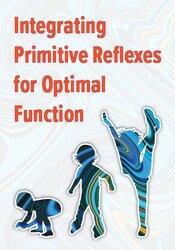3 Case Studies in Primitive Reflex Treatment
Learn what to look for and how to manage symptoms
Karen Pryor, Ph.D., PT, DPT, Varleisha (Gibbs) Lyons, Ph.D., OTD, OTR/L

The presence of retained primitive reflexes can exacerbate hyperactivity, inattentiveness, and challenges with processing sensory stimuli. Not only does trauma expose primitive reflex dominance, but it also influences overall function. As a physical or occupational therapist, it is vital to help clients integrate their primitive reflexes to reduce their influences on higher skill levels.
Primitive reflexes can be thought of as building blocks for active movement. They are used for protection and survival during infancy. However, when retained, primitive reflexes interfere with coordination, emotional regulation, sensory processing, and executive functioning. Our goal is to integrate these reflexes so that we can see voluntary conscious movements.
When working with clients, we need to know not only what to look for, but also how to manage the symptoms.
Case studies allow us to see what primitive reflexes look like in action and better see how effective treatment strategies can place primitive reflex patterns in the background. Watch as Karen Pryor, PhD, PT, DPT and Varleisha (Gibbs) Lyons, PhD, OTD, OTR/L show you how these reflexes truly impact client function through three case examples highlighted in their transformative online certification course.
Primitive reflexes can be thought of as building blocks for active movement. They are used for protection and survival during infancy. However, when retained, primitive reflexes interfere with coordination, emotional regulation, sensory processing, and executive functioning. Our goal is to integrate these reflexes so that we can see voluntary conscious movements.
When working with clients, we need to know not only what to look for, but also how to manage the symptoms.
Case studies allow us to see what primitive reflexes look like in action and better see how effective treatment strategies can place primitive reflex patterns in the background. Watch as Karen Pryor, PhD, PT, DPT and Varleisha (Gibbs) Lyons, PhD, OTD, OTR/L show you how these reflexes truly impact client function through three case examples highlighted in their transformative online certification course.
Access additional case studies and continue learning from the experts!

This online course will guide you how trauma exposes primitive reflex dominance and influences overall function. Through the lens of a physical therapist and an occupational therapist, this course will help you re-envision treatment planning and strategies. Learn to integrate primitive reflexes and reduce their influences on higher level skills. Plus…
- Be led through case studies on what happens when trauma exposes primitive reflex dominance and influences overall function.
- Learn step-by-step how primitive reflexes highlight the impact on developmental skills, learning, and behavior from function to dysfunction.
- Review the central nervous system anatomy and physiology as it relates to reflexive motor patterns, which includes the cranial nerves, and the various levels of the central nervous system.
- Gain access to case examples, useful handouts, and activities to address handwriting, dressing, eating, and positioning.
Meet the Experts:
Karen Pryor, PhD, PT, DPT, ND, CH, CFPS, has practiced for 40 years in the field. Dr. Pryor is an international speaker and owner of Health Sphere Wellness Center, an integrative therapy clinic in Jasper, Tennessee. Involved with orthopedic, chronic pain patients, she developed neuroplasticity techniques that are used in a wide variety of settings including orthopedic hospitals, out-patients clinic, home health, assisted living centers and nursing homes, to advance neurological -orthopedic programs. She is an author of a book teaching Neuroplasticity techniques. Dr. Pryor serves on several boards, including the Tennessee State University Physical Therapy School and Nashville State Community College. In 2010, she received the President's Volunteer Service Award for her contributions to advanced treatment by President Barack Obama. In addition to her pioneering neuroplasticity work, Dr. Pryor has served as an adjunct professor at Tennessee State University Occupational Therapy School, and Volunteer State Community College Physical Therapy Assistant program. She is a clinical instructor for several universities and colleges. With her years of experience and passion for complete wellness, Dr. Pryor advances a more expansive view of how to integrate therapy throughout the lifespan by using neuroplasticity techniques.
Learn more about their educational products, including upcoming live seminars, by clicking here.
Varleisha (Gibbs) Lyons, PhD, OTD, OTR/L, ASDCS, is an occupational therapist and author with over 18 years of experience working with children and adolescents diagnosed with Autism Spectrum Disorder, Sensory Processing Disorders, and Neurological Disorders. She is the Vice President of Practice Engagement and Capacity Building at the American Occupational Therapy Association (AOTA). Dr. Lyons is the former Scientific Programs officer at the American Occupational Therapy Foundation. She also served as the inaugural chair and director of the master’s programs in occupational therapy at Wesley College in Dover, DE, where she was a tenured associate professor. Prior to joining Wesley, Dr. Lyons worked at the University of the Sciences in Philadelphia, PA, where she served as the director of the doctoral programs in occupational therapy.
Dr. Lyons is steadfast and an expert in the field of neurology, cognition, and pediatric therapeutic intervention. She lectures and provides training on sensory processing strategies and self-regulation to practitioners, parents, and teachers throughout the country and internationally. As co-author of Raising Kids with Sensory Processing Disorders, she has provided families with strategies to understand and care for their children. Dr. Lyons is the developer of the Self-Regulation and Mindfulness program and author of the best-selling book, Self-Regulation and Mindfulness: Exercise and Worksheets for Sensory Processing Disorder, ADHD, and Autism Spectrum Disorder (PESI Publishing & Media). She is the co-author of a new book, Trauma Treatment in ACTION: Over 85 Activities to Move Clients Toward Healing, Growth and Improved Functioning (PESI Publishing & Media, May 2021). As co-author of Raising Kids with Sensory Processing Disorders, she has provided families with strategies to understand and care for their children.
Learn more about their educational products, including upcoming live seminars, by clicking here.
Learn more about their educational products, including upcoming live seminars, by clicking here.
Varleisha (Gibbs) Lyons, PhD, OTD, OTR/L, ASDCS, is an occupational therapist and author with over 18 years of experience working with children and adolescents diagnosed with Autism Spectrum Disorder, Sensory Processing Disorders, and Neurological Disorders. She is the Vice President of Practice Engagement and Capacity Building at the American Occupational Therapy Association (AOTA). Dr. Lyons is the former Scientific Programs officer at the American Occupational Therapy Foundation. She also served as the inaugural chair and director of the master’s programs in occupational therapy at Wesley College in Dover, DE, where she was a tenured associate professor. Prior to joining Wesley, Dr. Lyons worked at the University of the Sciences in Philadelphia, PA, where she served as the director of the doctoral programs in occupational therapy.
Dr. Lyons is steadfast and an expert in the field of neurology, cognition, and pediatric therapeutic intervention. She lectures and provides training on sensory processing strategies and self-regulation to practitioners, parents, and teachers throughout the country and internationally. As co-author of Raising Kids with Sensory Processing Disorders, she has provided families with strategies to understand and care for their children. Dr. Lyons is the developer of the Self-Regulation and Mindfulness program and author of the best-selling book, Self-Regulation and Mindfulness: Exercise and Worksheets for Sensory Processing Disorder, ADHD, and Autism Spectrum Disorder (PESI Publishing & Media). She is the co-author of a new book, Trauma Treatment in ACTION: Over 85 Activities to Move Clients Toward Healing, Growth and Improved Functioning (PESI Publishing & Media, May 2021). As co-author of Raising Kids with Sensory Processing Disorders, she has provided families with strategies to understand and care for their children.
Learn more about their educational products, including upcoming live seminars, by clicking here.
Topic: Reflex
Tags: Occupational Therapy (OT) | Physical Therapy (PT) | Reflex | Strategy | Success | Therapy Tools



